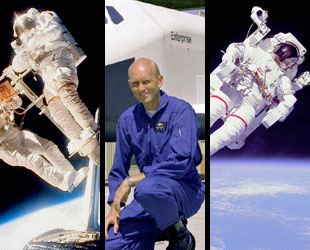 advertisements advertisements
|

|
Hall of Fame to induct pilot, spacewalkers

Astronauts in action: Joseph Allen, F. Gordon Fullerton and Bruce McCandless will be added to the Astronaut Hall of Fame. (NASA) |
January 17, 2005 — An early Space Shuttle test pilot and two pioneering spacewalkers have been selected by a committee of their peers and colleagues to be inducted this April into the U.S. Astronaut Hall of Fame in Florida.
Announced late last week by the Astronaut Scholarship Foundation, which oversees the selection, the 2005 class of inductees are the fourth group of Space Shuttle fliers to be honored with inclusion in the Hall, which opened in 1990, and counts all Mercury, Gemini, Apollo and Skylab astronauts among its 57 members.
The 2005 inductees are Joseph Allen, Gordon Fullerton, and Bruce McCandless.
McCandless will be forever remembered by an iconic photograph taken of him flying freely — without tethers — over the Earth on mission STS-41B. During that flight, his first, McCandless tested the Manned Maneuvering Unit (MMU), a jet-powered backpack that allowed him to float away from the shuttle. Six years later, he launched to space aboard STS-31 / Discovery to deploy the Hubble Space Telescope.
Selected for the Air Force Manned Orbiting Laboratory before transferring to NASA, Fullerton flew two shuttle flights in space and before them, five captive and free approach and landing tests with the shuttle Enterprise. He piloted the third flight of the shuttle Columbia, testing the robotic arm, and landing the first and only time at White Sands, New Mexico due to wet conditions at Edwards Air Force Base. Six minutes into Fullerton's second mission STS-51F, which he commanded, a premature engine shutdown forced the only abort in Space Shuttle history on an otherwise routine Spacelab science-focused flight.
Allen flew to space twice, on missions STS-5 in 1982, and STS-51A in 1984. His rookie flight, the shuttle's first operational mission, deployed two satellites. His second mission featured the world's first space salvage. Using the jet backpack first tested by McCandless, Allen and his crewmate Dale Gardner captured two malfunctioning satellites. While Gardner worked to prepare for berthing in the payload bay, Allen held the half-ton spacecraft steady above the orbiter for 90 minutes.
The Astronaut Scholarship Foundation, joined by more than 25 Hall of Fame astronauts, will honor the inductees at an April 29, gala to be held at the Apollo / Saturn V Center in Florida. The following day, the astronauts and public will gather at the Kennedy Space Center Visitor Complex for an induction ceremony. Among those who are expected to join the festivities are John Glenn, James Lovell and ASF Chairman Owen Garriott.
This year's inductees were selected by a blue-ribbon committee composed of former NASA officials and flight controllers, journalists, and historians as well as the Hall of Fame astronauts. To be eligible, an individual must be a U.S. citizen and have been out of the active astronaut corps at least five years. Committee members consider not only accomplishments in space, but how candidates contributed to the advancement of space exploration both before and after their missions.
collectSPACE editor Robert Pearlman was a member of the committee that selected this year's inductees. |

© collectSPACE. All rights reserved.

|
|

|

|
